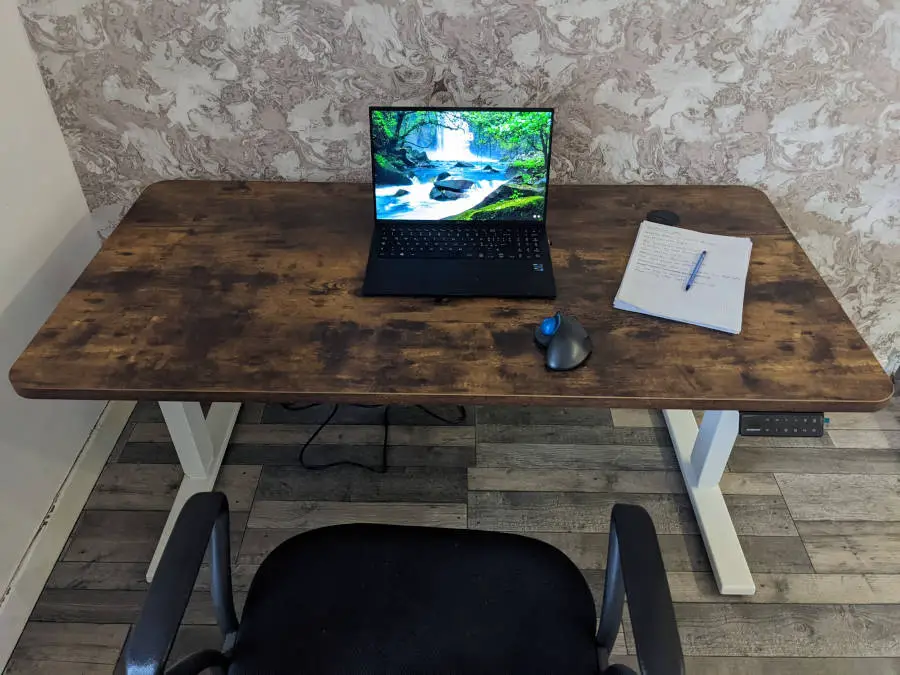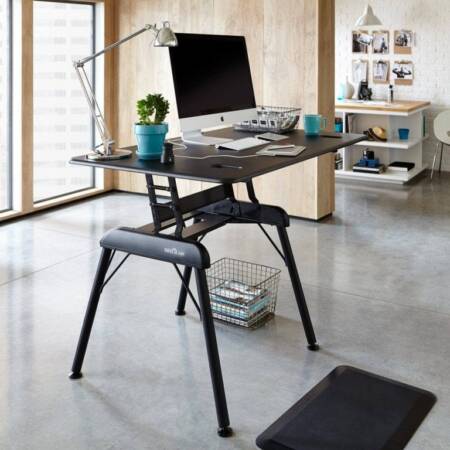
Best Home Office Desk Setup For Your Mental & Physical Health
Your home office desk is a very important and substantial equipment in your home office setup. Choosing the correct work desk type depends on your preferences and requirements.
The most common types of desks are laptop desks, desktop computer desks, standing desks, electric desks, and ergonomic workstations. Each type of desk has its own advantages and disadvantages. We will cover each one to give you an idea of which desk may suit you.

April 27, 2024 00:56
Desktop Computer Desks
Desktop computer desks are designed to support large and bulky desktop computers. They usually include space for one or more monitors and a keyboard and mouse pad. You can place your main computer workstation on top of the desk or sometimes on a dedicated shelf below it.
These types of desks are normally designed with a printer in mind as many people require space for a printer to be attached to the computer.
Standing Desks
April 27, 2024 00:56
Standing Desks are designed to help you maintain good posture while standing. They usually include a keyboard tray, a mouse pad, and a monitor stand. There are two main types of standing desks: Fixed standing desks and adjustable electric desks.
A fixed-standing desk doesn’t allow you to adjust the height of the table. An adjustable standing desk allows you to change the height of the table according to your preference.
Ergonomic Workstations
Ergonomic workstations are designed to provide comfort and ease when working. They usually include a chair, a keyboard tray, a monitor stand, and a mouse pad/keyboard. Some models even include a massage function. They are not as popular these days as electric desks which give you better working options.
Electric Stand & Sit Desk
Is There Any Evidence that a Electric Desk Improves Health?
April 27, 2024 00:56
This question is currently on the fence for negotiation as some say no benefits are gained from standing at work. Personally, I find that very hard to believe. Just the fact that sitting at a desk for 8 hours every day is NOT good for your health, well-being and posture.
If you like to work standing up, then this type of desktop computer desk is perfect for you.
Some evidence suggests that prolonged sitting increases blood pressure and heart rate. In addition, sitting for long periods of time increases cortisol levels, which leads to increased stress. Standing up from a seated position helps reduce these effects. It also reduces back pain and neck stiffness.
The points alone indicate that sitting at a desk all day harms your long-term health. For me, it is a no-brainer to use a stand-up electric desk to its full benefit.
The use of standing desks has been increasing recently. However, there is no scientific evidence that supports their benefits. The main reason why people choose to use them is that they think that sitting too much is bad for your health.
However, there is little evidence that standing at work improves productivity. A study published in 2017 found that working while standing did not improve performance compared to sitting. Another study found that workers who stood during breaks were less productive than those who sat.
Can standing for too long can actually harm your health?
Prolonged periods of standing without moving can lead to adverse health effects. When someone stands still for extended times, blood begins to pool in the legs and feet due to gravity. Over time, this pooling may result in varicose veins as blood vessels enlarge and become twisted.
Wikipedia
Standing motionless also immobilizes the back, hips, knees, and feet joints, potentially leading to pain and stiffness. Taking occasional walking breaks can help prevent blood pooling and joint immobilization from frequent standing.
A study noted in this article by Harvard University disagrees with the above. It clearly shows that a standing desk is more beneficial than sitting at a desk all day long. It is well worth reading. In the study published in The National Library of Medicine, 74 people were tested with Oxygen masks, and the results were clearly positive for using a stand-up electric desk rather than just sitting at an electric desk all day.
One article written by webMD showed that office workers who used standing desks had better cholesterol levels than those who worked sitting down. The highest levels of cholesterol burn came from those who had a treadmill electric desk. I know, who puts a treadmill underneath a computer?
An article written by Staverton has two studies covering standing desks and standing at work, concluding that limiting the amount of time people spend sitting and encouraging them to stand while working could significantly improve their mental health.
In summary, there is limited evidence that standing at work is beneficial. If you want to try out a standing desk, ensure you do so under medical supervision.
Laptop Desks
Laptop desks are designed to fit laptops and tablets. They usually come with a keyboard tray and a monitor arm. This type of desk is suitable for people who use their laptops at home or office. It’s easy to move around because they don’t require much space.
You will get a mixed view when looking for a laptop desk as many images show a very small tray type of desk where you can sit at the settee with the laptop obove your legs on a small tray type desk. Personally I would never even consider one of these desks.
Is It Worth Getting an Electric Adjustable Office Desk?
An adjustable office desk is useful for many people working from home or at their offices. It allows you to adjust your working position according to your comfort level and health.
The main advantage of having an adjustable desk is that it gives you flexibility when sitting down and standing up. You can easily change your posture while working. This helps prevent back pain and neck problems. Also, if you spend long hours sitting at a computer, an adjustable desk will help keep your body healthy.
There are some disadvantages to having an adjustable desk. For example, reaching certain objects such as bookshelves or cabinets might be difficult. Also, you might feel uncomfortable because you cannot sit straight when adjusting the height of your chair.
If you want to get an adjustable desk, you should consider how often you use it. If you only use it occasionally, it’s probably not worth buying one. However, if you plan to use it daily, it’s worth investing in an adjustable desk.
The Best Rated Electric Desk USA
Looking though all of the electric desks on Amazon This desk stands out the most as being the electric desk that receives the best reviews and the most sales. This is the desk I would seriously consider buying today.
This is my current electric desk that is shown here on this article. I have owned this desk for nearly 2 years, and it has been faultless in that time.
April 27, 2024 00:56
The Best Rated Electric Desk UK
In the UK, looking at reviews, I would seriously consider this electric desk if I were buying one today. I currently own two electric desks, the MaideSite, and the Flexispot. Neither is chosen here as the top-rated desk, although I must say that both of my electric desks have performed perfectly in the time that I have owned them.
The top-ranking desk in the UK is the Fezibo. It looks very similar in design to my Madesite desk. It is very highly thought of.
April 27, 2024 00:56
How Long Should You Spend Standing at Your Desk?
Because you need to keep the blood flow moving in your legs for many reasons, it is worth your time researching the maximum amount of time you should spend, on any occasion, standing at your desk.
The blood in your veins needs to flow through the body to prevent blood clots, so sitting or standing for long periods of time is not very healthy. An article by Lisa Lombardi of the Wall Street Journal goes through the questions and answers you would be looking for.
The benefits of having a standing desk include lower back pain, improved posture, increased energy levels, and reduced stress. However, there are some disadvantages too.
For example, sitting for extended periods can cause blood clots, increasing the risk of heart disease. Also, prolonged sitting can lead to obesity.
The most common types of desks include a standard desktop, a laptop desk, and a treadmill desk. A standard desk usually has two legs and a flat surface. Laptop desks are similar to standard desks except that they have a built-in screen and keyboard.
Treadmill desks are different from regular desks because they allow users to walk around while seated. They come in many shapes and sizes, including floor models, wall-mounted units, and portable versions.
Standing Vs Sitting At Work – The benefits of standing up while working include:
- Better posture
- More energy
- Improved concentration
- Increased productivity
- Decreased risk of back pain
- Reduced stress levels
How Long Should You Wait Before Standing Up From Your Desk?
The average person stands for 5 hours a day. The average workday is 8 hours.
So if we add these two together, we get 13 hours. If we divide this number by 7 days, we get 1.8 hours daily. This means that we should take breaks every hour. If it was me I would take a break every 40 minutes. I am now in my 60s, physically very fit at 82 kgs and find 40 mins is enough to max out the brain, and to get the legs back in motion.
A break does not really mean a cigarette break. A break is a short walk to get the blood flowing through the legs and veins and circulating. Going down to the cigarette smoking spot and standing there for 10 minutes will more than likely make things worse rather than better. It would be far more beneficial to walk and smoke rather than just stand again in the same spot for 10 minutes.
Some people say they do not feel well when sitting down too much. They claim that their body gets tired after sitting for longer periods of time. Therefore, they try to avoid sitting for too long at one time.
Many studies show that people who stand during the day live longer than those who do not. In addition, they tend to have fewer health problems. Even studies show that people whose jobs require them to stand for long periods tend to have less back pain.
To stay healthy and enjoy life, you should stand while working. It is recommended that you stand for 30 minutes every hour. You can use the following steps to help you decide how long you should stand:
1) Stand up straight. Your spine should be aligned vertically.
2) Place your hands on your hips.
3) Breathe deeply.
4) Stretch your arms out in front of you.
5) Lift your chest slightly.
6) Look forward.
7) Focus on your breathing.
8) Relax your shoulders.
9) Do not hold your breath.
10) Smile.
11) Repeat the above steps until you reach 30 minutes.




